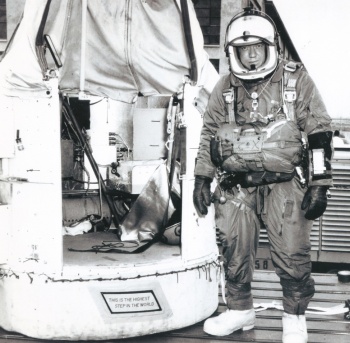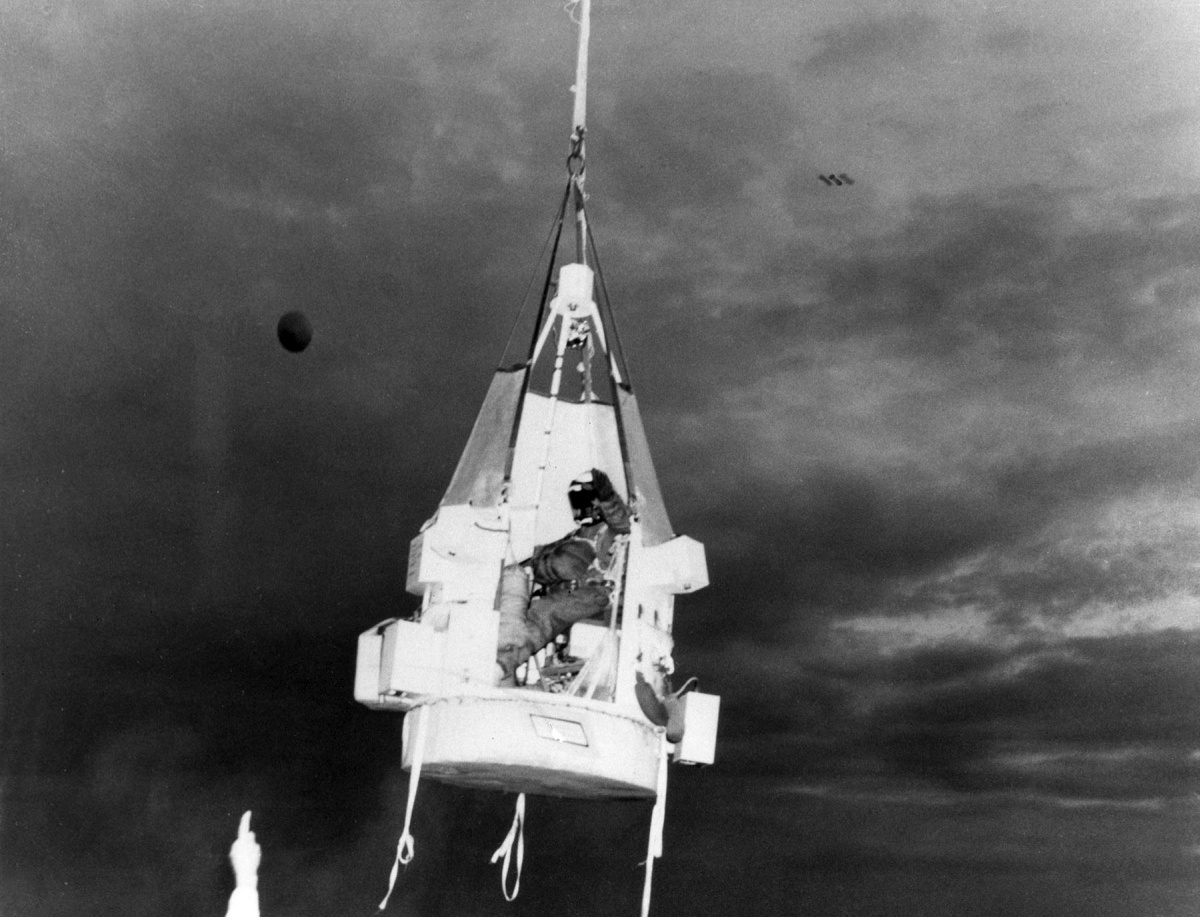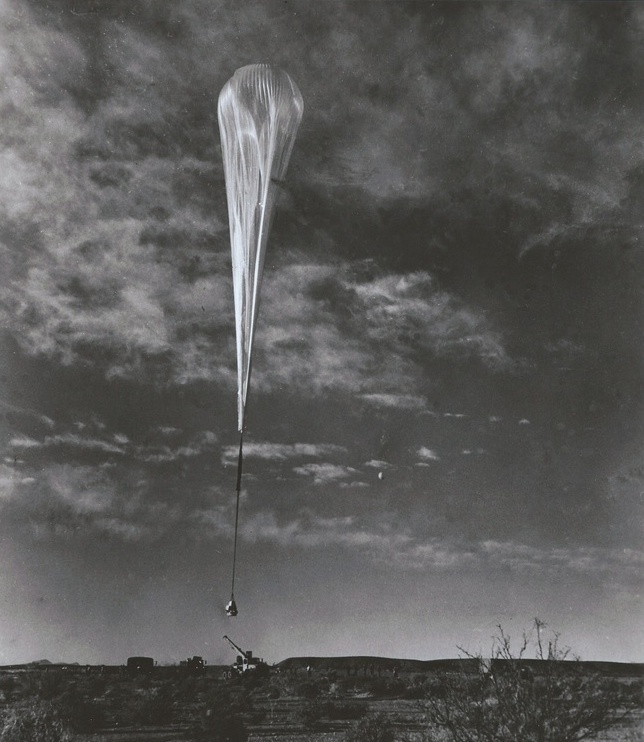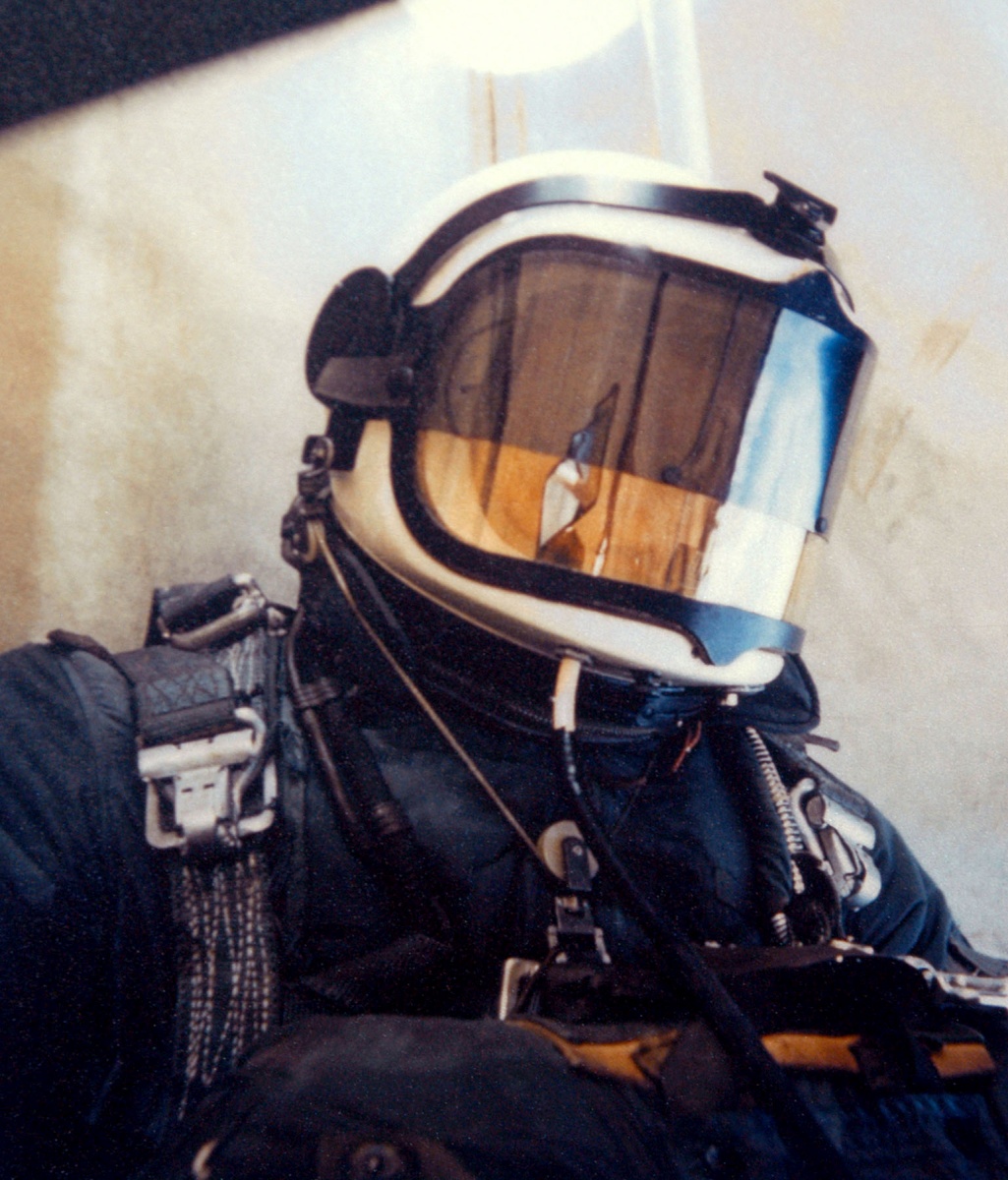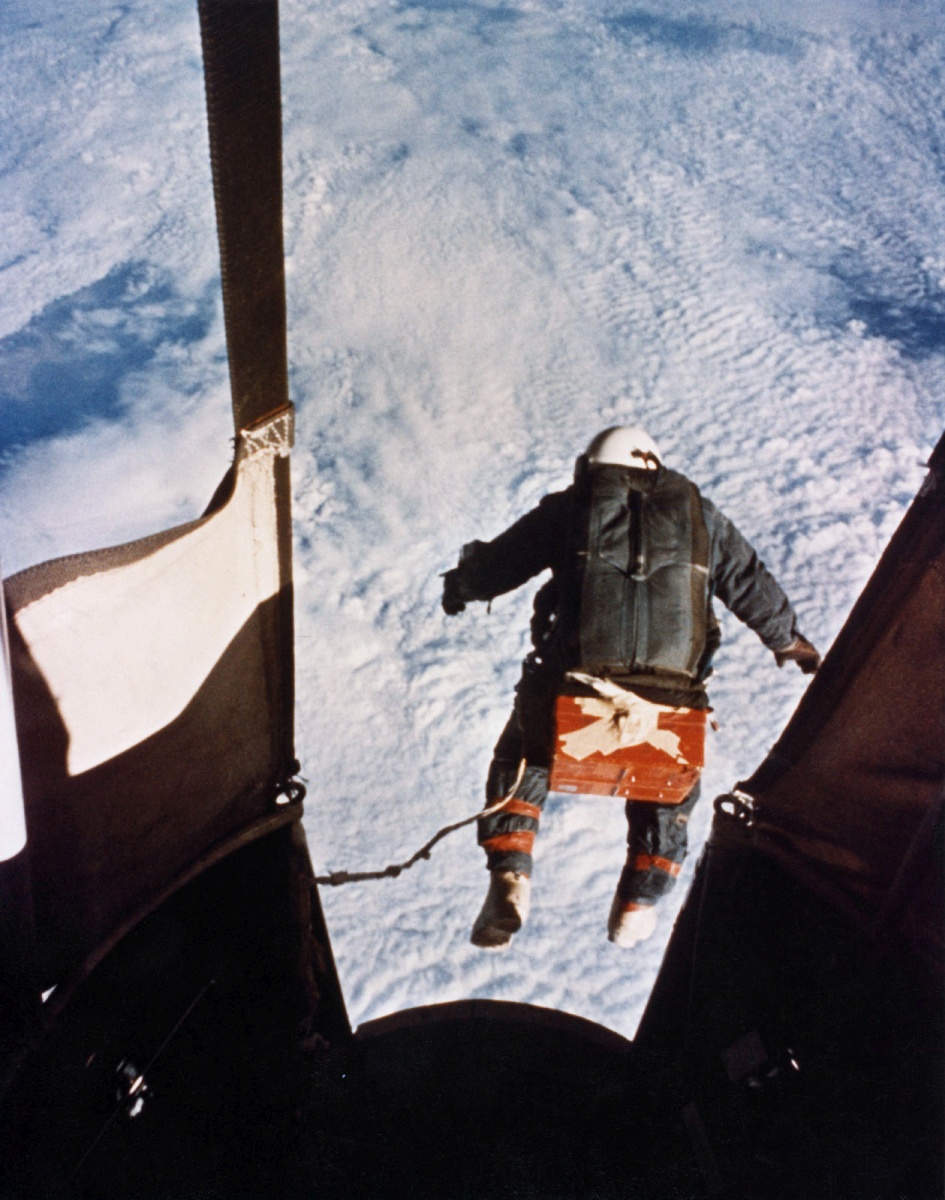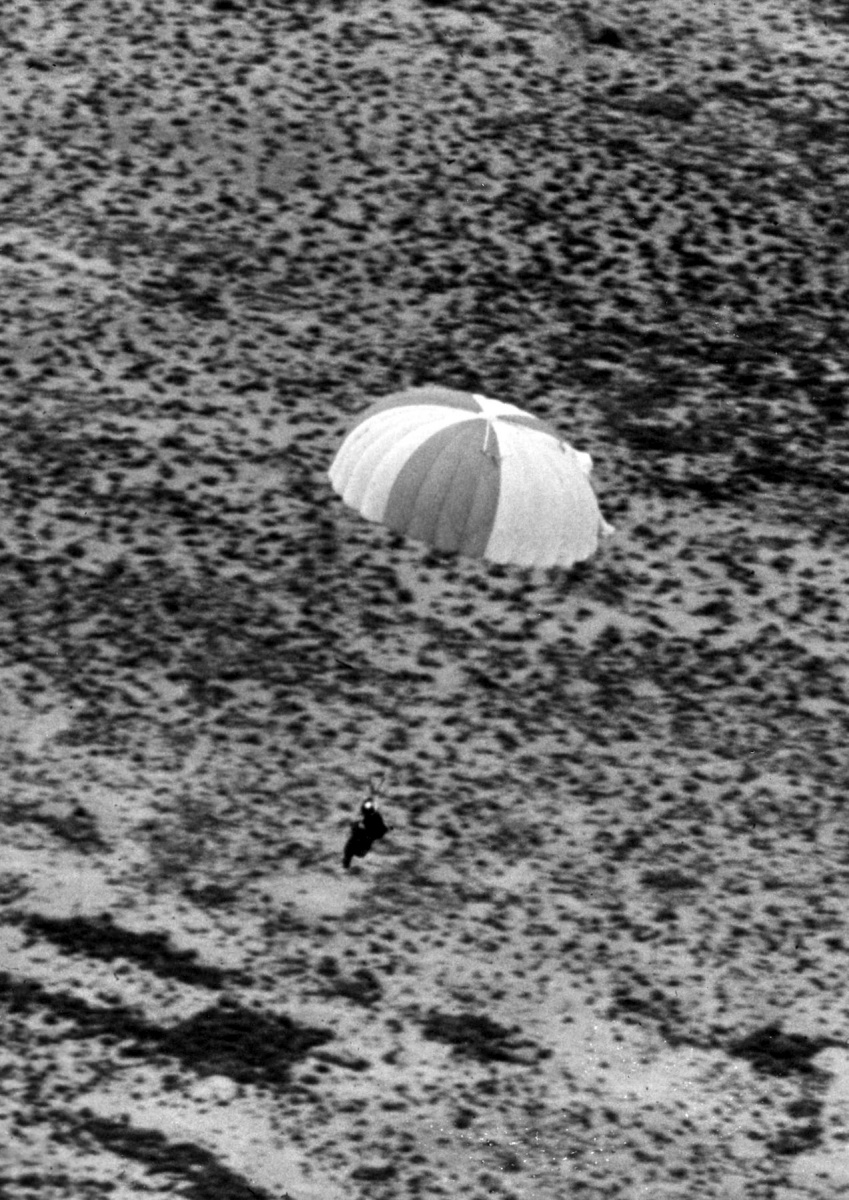Purpose of the flight and payload description
EXCELSIOR (Latin word for "higher" or "even upward") was an U.S. Air Force program, which was designed to test whether pilots could survive high-altitude bailouts.
Tests conducted by the Aeronautical Research Laboratory at Wright Air Development Center demonstrated that a falling body could reach the rate of 465 revolutions per minute about the vertical axis of the body while it was in the prone position. If a pilot bailed out at high altitude, he had little choice other than to fall. Therefore, equipment was needed to stabilize the jumper during the fall. In addition, this equipment needed to be tested to ensure that practicality agreed with theory.
Initially anthropomorphic dummies falling from planes and balloons were drafted as test subjects obtaining important data under the HIGH DIVE program.
Early psychological evaluations showed that pilots who bailed out had a tendency to try to remain with the last link of their aircraft: the seat. Thus man-seat separation devices were developed which 'threw' the pilot out of the ejection seat. Therefore, the next step was to stabilize the pilot with a drogue parachute.
Francis F. Beaupre developed a stabilization parachute which, in theory, would work . After bailout, the pilot would pull the 'orange apple,' which started the parachute deployment sequence. The first to deploy, after a few seconds delay, was an 18 inch pilot parachute. This, in turn, pulled out a 6 foot stabilization parachute, followed by three-quarters of the main parachute. When the person passed through a predetermined altitude, which in the early 1960s was determined to be 14,000 feet, the aneroid barometer would start the release sequence allowing the 28 foot diameter main parachute to fully deploy.
The Beaupre stabilization parachute worked at altitudes where jet aircraft were normally flying.
It then became necessary to see if the system would work at higher altitudes where the newly introduced X-15 and other research aircraft and space capsules would fly. Accordingly, the Aeromedical Research Laboratory at Holloman AFB began a series of parachute test using balloons, under the project's name EXCELSIOR.
The three jumps were made by then Captain Joseph W. Kittinger Jr., from an open gondola hanging from a stratospheric balloon so he wore a full pressure suit.
Details of the balloon flight
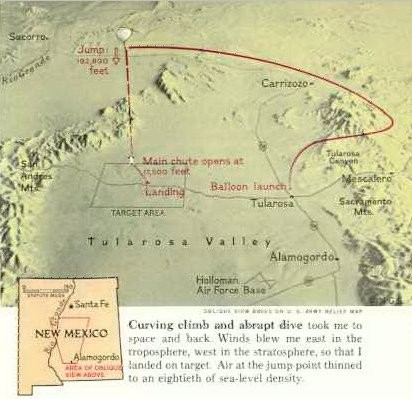
Balloon launched on: 8/16/1960 at 5:29 local
Launch site: Holloman Air Force Base, Alamogordo, New Mexico, US
Balloon launched by: Balloon Branch, Holloman Air Force Base (HAFB)
Balloon manufacturer/size/composition: Zero Pressure Balloon General Mills - 2.940.000 cuft (1.5 mils Tapped)
Flight identification number: HAFB Nº 1146
End of flight (L for landing time, W for last contact, otherwise termination time): 8/16/1960
Landing site: In a predetermined zone of the White Sands Missile Range W of launch site.
Overall weight: 2320 lbs
The balloon was launched from an abandoned airstrip near Tularosa, northeast of Holloman Air Force Base, New Mexico, at 5:29 am. The gondola rested in a flatbed truck acting as launch vehicle. The balloon was hold in vertical position launch by a crane. At launch time a first squib was fired to separate balloon from the crane and a second one to cut the truck straps. The balloon raised at 1200 feet / minute and initially heading to east. After reaching near float altitude the balloon started to travel west to the target area.
Captain Kittinger jumped from a height of 102,800 feet, at 7:12 am. With only the small stabilizing chute deployed, him fell for 4 minutes, 36 seconds. He experienced temperatures as low as minus 94 degrees Fahrenheit and a maximum speed of 714 miles per hour, exceeding the speed of sound. The 28-foot main parachute did not open until Kittinger reached the much thicker atmosphere at 17,500 feet. He finally safely landed in the New Mexico desert after a 13 minute 45 second descent.
This was the third and last jump of the program. At 5:29 on 16 August 1960 Kittinger lifted off from an old abandoned airstrip just north of Tularosa, New Mexico, and east of Highway 70. During the ascent, the pilot began experiencing severe pain in his right hand caused by a failure in his pressure glove. Apparently the glove failed due to a crack in the oxygen line. This would have been enough to abort the mission, but Kittinger did not initially report the problem because he did not want to terminate the test.
After several manouvers to reduce the ascent rate avoiding damage of the balloon, the craft reached an altitude of 102,800 feet, thus having 99.2 percent of the atmosphere beneath him. Only then -just prior to stepping out of the gondola- Kittinger reported the glove damage.
After a long inspiration and after saying "Lord, take care on me..." the pilot jumped. Once again, the Beaupre multistage parachute functioned perfectly. After falling for 13 seconds, his six-foot (1.8-meter) canopy parachute opened and stabilized his fall, preventing the flat spin that could have killed him. Only four minutes and 36 seconds more were needed to bring him down to about 17,500 feet (5,334 meters) where his regular 28-foot (8.5-meter) parachute opened, allowing him to float the rest of the way to Earth.
The achievements by Kittinger during Project Excelsior were:
(I) proof by survival that the Beaupre multistage parachute could provide stabilized free-fall descent from altitudes greater than 20 miles,
(II) proof that the MC-3 partial pressure suit and other items functioned under actual emergency open-air conditions, since previously they had been tested only in altitude chambers, and
(III) demonstration that a man exposed to the stress of space emergency conditions could, with minimum protection, endure and perform for more than an hour and override equipment failures.
After the flight he was awarded an Oak Leaf Cluster to the Distinguished Flying Cross.
The feat had impact in popular culture. In May 2006, the Scotish duo "Boards of Canada" made a musical video of their track "Dayvan Cowboy" (included in the EP "Trans Canada Highway") depicting in the first half of it the footage took by the Air Force on Kittinger's jump.
In 2011, Stephen Deazley and Martin Parker, inspired by the EXCELSIOR project created an original music and film piece called "Man High - Leaping from Space", based on the original documentary footage of the jump remixed by artist & media designer, Andy McGregor. The piece was premiered on Saturday 24th September, performed by Music at the Brewhouse, as part of Space Wide Open, UNESCO's Glasgow City of Music family event.
To see these videos online look at the external references for the links.
More recently, Kittinger is participating in the Red Bull Stratos effort, acting as Flight Operations And Safety, Capcom I. This civil program aims to break the record established by the Excelsior program back in 1960.
Postal cover issued on launch day commemorating the flight
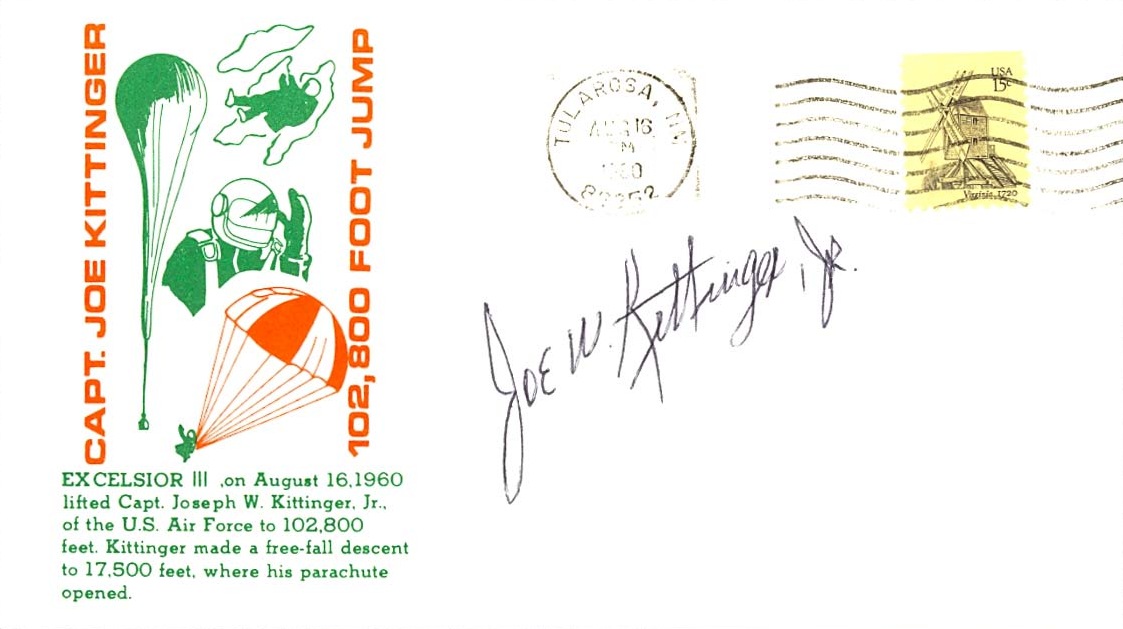
External references
- Joseph W. Kittinger and the Highest Step in the World an article by Gregory Kennedy
- A life in pictures: Joe Kittinger Orlando Sentinel
- Balloon Branch Record U.S. National Archives
- Come Up and Get Me: An Autobiography of Colonel Joe Kittinger book by Craig Ryan
- Dayvan Cowboy by Boards of Canada Musical Video inspired in Kittinger's jump
- Discussion of Project Excelsior Proceedings of the National Conference on the Peaceful Uses of Space (2nd) Held in Seattle, Washington on May 8-10, 1962, Page 249
- Excelsior Gondola exhibited at the National Museum of the USAF
- Fastest Skydiver Joseph Kittinger Aerospaceweb.org
- Free-Fall from Near Space Damn Interesting web site
- Just Give the One Finger Salute and Keep Going by Tim O'Reilly at O'Reilly radar
- Man High - Leaping from Space An original music & film piece inspired by the Excelsior program
- Profile of Joe Kittinger at Red Bull Stratos website
- Skydive from the Stratosphere Nova Online. Including an interactive game on Kitinger's jump
- Skydiving from Space-Part I: Joseph W. Kittinger's Long, Lonely Leap Art of manliness blog
- The physics of Colonel Kittinger's longest lonely leap Phys. Educ. 43 477 (2008)
912If you consider this website interesting or useful, you can help me to keep it up and running with a small donation to cover the operational costs. Just the equivalent of the price of a cup of coffee helps a lot.

